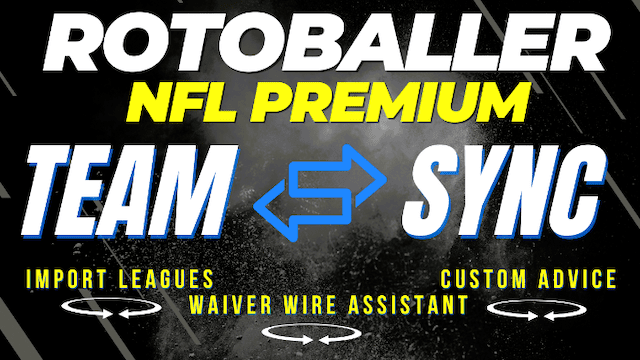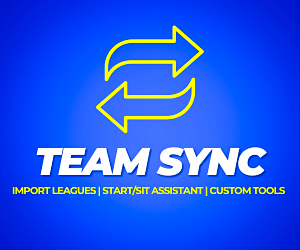Frank Dyevoich breaks down the NFL free agency process, dissecting each different aspect and how it can help fantasy football managers prepare for the 2021 season.
Now that Super Bowl LV is behind us, it's time to start looking ahead to the 2021 season. The first major event of the NFL offseason is the start of free agency. The idea of free agency seems pretty elementary, players who are no longer under contract can sign with new teams, usually for much more money. However, free agency is a very complex process, but have no fear, I am going to explain it to you like you are five.
NFL players enter free agency for a variety of reasons. Some players’ contracts are ending, some are cut from the team, and some can only sign with new teams under certain conditions. Further, there are two designations of free agents, restricted and unrestricted, and perhaps the most complex aspect of free agency is the multitude of ways that teams can protect themselves from losing a player that they covet.
Teams can do this by applying the franchise tag or a transition tag on the player as well as a first, second, or original round tender. This offseason is going to be one of the most difficult ones in recent memory for NFL teams who are used to the salary cap being raised each year because the salary cap is expected to drop from $198.2M to approximately $180M due to the financial hit the league took from COVID-19. So, let’s simplify all of these concepts and options so you can follow along when the free agency frenzy begins in March.
Be sure to check all of our fantasy football rankings for 2025:- 2025 fantasy football rankings
- Running back (RB) rankings
- Wide receiver (WR) rankings
- Quarterback (QB) rankings
- Tight end (TE) rankings
- Defense (D/ST) rankings
- Kicker (K) rankings
- FLEX rankings
- Dynasty rankings
Important Dates of 2021 NFL Free Agency
Times listed are Eastern Standard Time
February 23, 2021: The first day that teams can apply the franchise tag or transition tag. This period lasts for 15 days.
March 9, 2021, at 4:00 PM: The deadline for teams to apply the franchise tag or transition tag.
March 15, 2021, at 12:00 PM: The start of the legal tampering period.
March 17, 2021, at 4:00 PM: The end of legal tampering; The start of the new league year; the official start of free agency where newly signed player contracts become official; the start of the NFL trading period where offseason trades of players under contract become official (i.e. Matthew Stafford to the Los Angeles Rams); The deadline for NFL teams to exercise any player options they have on 2020 contracts; the deadline for NFL teams to make their qualifying offers (tenders) to restricted free agents to preserve their Right of First Refusal; and the deadline for every NFL team's top-51 salaries to be under the salary cap.
April 23, 2021: The deadline for restricted free agents to sign their offer sheets.
Restricted v. Unrestricted Free Agents
When it comes to NFL free agents, there are two types, restricted and unrestricted. An unrestricted free agent is as simple as it sounds, the player is not under contract and is free to sign with any team under any terms. A player becomes an unrestricted free agent in one of four ways. First, the player is released from his team and is not subject to waivers. A player is not subject to waivers if that player has four accrued seasons (six or more regular-season games on a team's active/inactive, reserve/injured, or reserve/physically unable to perform list) in the NFL. Second, the player is released to waivers but goes unclaimed. Third, the player has four or more accrued seasons, was under contract, and the contract has fully expired. Last, the player was not drafted in the NFL Draft so he is free to sign with any team.
Restricted free agents are not as simple. Restricted free agents have strict conditions on the terms under which they can sign with their original team or negotiate with other teams. A player becomes a restricted free agent when he has three accrued seasons in the NFL and his contract is about to expire. This becomes complicated when rookies, normally signed to four-year contracts, are released from their original team before their contract expires. Since he did not accrue four seasons, the player goes on waivers. If he goes unclaimed on waivers, then the player becomes an unrestricted free agent.
A simple example to explain this is Cleveland Browns running back Kareem Hunt. Hunt was signed to a four-year deal when he was drafted by the Kansas City Chiefs in 2017. He played a full season in 2017, but he was released in 2018 after 11 games when video footage leaked of Hunt getting physical with a female at a hotel. At this point, he had two accrued seasons. Once he was released, he went on waivers since he did not have four accrued seasons. Due to his off-field altercation, he was not claimed off of waivers. At this point, Hunt became an unrestricted free agent. In 2019, Hunt signed a one-year deal with the Cleveland Browns and played eight games. When the 2020 free agency period rolled around, Hunt was a restricted free agent because although his contract was expiring, he only had three accrued seasons.
The restrictions placed on restricted free agents are they must play under a one-year contract for a salary that is pre-determined by the league if they do not reach a long-term agreement with their team. However, the player is allowed to negotiate with other teams for a long-term deal but is only able to sign an offer sheet with a new team, not a contract.
An offer sheet lays out the full terms of the proposed contract the new team is willing to sign the player to. To protect themselves from losing a valuable player designated as a restricted free agent, the original team can assign a “tender” to the restricted free agent of either a first-round tender, second-round tender, an original round tender, or a Right of First Refusal tender. There is no limit to the number of tenders a team may apply. If the team has seven restricted free agents, they can apply seven tenders. The only restriction is that if a player was drafted after the round of the tender used on him, the team may only use a subsequent round tender or receive a subsequent round draft pick for all remaining restricted free agents that were drafted in that same round.
Explained another way, if a team uses a first-round tender on a player drafted after the first round, the team may only use a second-round tender on any remaining restricted free agents that were drafted in the first round. If a second-round tender is used on a player drafted in the third round or later, the team may only receive a third-round pick for any remaining restricted free agents that were drafted in the second round. All tenders may be removed, which results in the player becoming an unrestricted free agent, despite not having four accrued seasons.
The tender allows the player to negotiate with other teams but protects the original team by giving it what is called a Right of First Refusal. The Right of First Refusal means that the original team has the right to match any offer made to the tendered player. If the new team signs a restricted free agent to an offer sheet, the original team has the right to match that offer and keep the player. If the original team matches the offer sheet, then it creates a contract with the tendered player. If the team does not match the offer sheet, then the new team creates a contract with the tendered player, and the original team receives a draft pick as compensation from the new team which is equal to the tender that was assigned to the player.
For example, Player A was given a first-round tender, therefore the new team must give up its first-round pick in the upcoming NFL Draft to the original team in order to sign the restricted free agent to a contract. If Player A was given an original round tender and he was drafted in the fourth round of the NFL Draft, then the new team must give up a fourth-round pick in the upcoming NFL draft to sign Player A. The exception is the Right of First Refusal tender which is a tender without any compensation if the player signs with a new team. The team still gets the Right of First Refusal to match the offer, but it receives zero compensation if they decline to do so. Sticking with Hunt as an example, he was given a second-round tender. He chose to sign the tender and play under the one-year contract. Now, Hunt has four accrued seasons and is thus an unrestricted free agent in 2021.
So why wouldn’t every team place a first-round tender on all of their restricted free agents to ensure the most compensation if they lose that player to another team? The tender picked also determines the salary for that player if a long-term agreement is not reached. A first-round tender is obviously the most costly to a team.
2021 Projected RFA Tenders according to overthecap.com

Franchise Tag v. Transition Tag
When a superstar player is set to be an unrestricted free agent, teams have two options to prevent that from happening. They can apply the franchise tag or the transition tag to an impending free agent. The franchise tag also has two designations for teams to use, the exclusive franchise tag and the non-exclusive franchise tag. Regardless of which option a team takes, it is important to remember that each team can only use one tag each year. Not one of each tag, but only one amongst the three. Teams can tag a restricted free agent, but most of the time a first-round tender is enough protection at a much lower salary, so it's rare. Like tenders for restricted free agents, franchise and transition tags may be removed which results in the player becoming an unrestricted free agent.
Franchise Tag
A franchise tag is essentially a one-year contract. The NFL pre-determines the salary for players who play under the franchise tag and the player has to either sign the tag and play for that salary or negotiate a long-term deal with his team before the expected deadline of July 15, 2021 (official deadline currently unannounced). The salary for a franchise-tagged player is set in one of two ways, either by averaging the top-five salaries by position for the previous league year or if it’s higher, 120% of a player’s salary from the previous season. This means players like quarterbacks and defensive ends will have a much higher salary under the franchise tag than positions like a safety, tight end, or kicker.
Further, a team can franchise tag a player up to three times. The second franchise tag on a player requires a 120% increase from the player's salary under the initial franchise tag, but if a team wants to franchise tag a player three years in a row, the player’s salary is either an increase of 144% from the second franchise tag salary, an increase of 120% of the franchise tag salary for his position, or the quarterback franchise tag salary, whichever is higher. This means that if a team wanted to franchise tag a tight end for three years straight, his third year under the tag would give him a one-year salary equal to the quarterback franchise tag salary, not tight ends. That is why you never see a player tagged three years in a row.
A franchise tag can also be either exclusive or non-exclusive. An exclusive franchise tag is an equivalent of putting the player in jail. He is not allowed to negotiate with any other teams and must either sign a long-term deal by the July deadline or play under the franchise tag for one-year and accept the pre-set salary. A non-exclusive franchise tag allows the player to negotiate with other teams but protects the original team by giving it a Right of First Refusal, similar to restricted free agents. However, the compensation received by the original team for a non-exclusive tagged player is much steeper than any of the tenders for a restricted free agent.
If another team reaches an agreement with the non-exclusive franchise-tagged player, they must sign that player to an offer sheet that the original team has a right to match. If the original team does not match the offer sheet, the new team must give up two first-round picks as compensation for signing the player. This rarely happens because teams are reluctant to give up two first-round picks for any player, and any player worth giving up two first-round picks for will likely be given the exclusive franchise tag by his original team.
Transition Tag
The second option an NFL team has to protect their superstar player from leaving is the transition tag. This is essentially a poor man’s non-exclusive franchise tag. The transition-tagged player has the right to negotiate with other teams, and if another team signs the player to an offer sheet, the original team has a Right of First Refusal to match the offer. The difference is that if the original team does not match the offer, the player signs with the new team, but the original team does not receive any draft pick compensation in return. So, why would a team use the transition tag instead of the non-exclusive franchise tag?
First, the pre-determined salary for a transition-tagged player is much less than a franchise-tagged player. Second, the transition tag allows teams to test the market for a given player because prospective teams usually will not sign a non-exclusive franchise-tagged player to an offer sheet given the two first-round picks they will have to give up if they sign him. If another team knows they don’t have to give up anything to sign the transition tagged player, they are much more likely to make an offer, which gives the original team a very good idea on the player’s market without negotiating with the player, making him available or negotiating trades. A team might be willing to sign a player for five years and $50M, but the player might sign an offer sheet with another team for five years and $43M. In this scenario, the original team gets to keep the player under the offer sheet contract, $7M cheaper.
However, there was a significant decrease in the use of transition tags until 2011. Before 2011, prospective NFL teams started adding language to their offer sheets that basically guaranteed that the original team would not match the offer. The best example of this happened in 2005 when the Seattle Seahawks placed the transition tag on offensive guard Steve Hutchinson. The Minnesota Vikings signed Hutchinson to an offer sheet for $49M with $16M guaranteed but included language that said the entire $49M contract was fully guaranteed if Hutchinson were not the highest-paid offensive linemen on the team he signed with. He would have been the highest-paid offensive lineman on the Vikings, but he would have been the second-highest-paid offensive lineman on the Seahawks.
This offer sheet basically meant if the Seahawks wanted to match the offer, Hutchinson’s entire $49M contract would be fully guaranteed. The Seahawks challenged the language in binding arbitration under the collective bargaining agreement ("CBA") and lost. As a result, they did not match the offer sheet and the Vikings signed Hutchinson without having to give up any compensation to the Seahawks. This kind of language in an offer sheet was known as a “poison pill” and was thankfully banned in the 2011 CBA.
2020 Projected Franchise and Transition Tenders according to overthecap.com
Legal Tampering Period
Officially, free agents can’t sign a contract with a new team until 4:00 PM on March 17, 2021. It is against league rules for players to talk to other teams about a contract while they are still under contract with their current team. However, the NFL allows impending unrestricted free agents to begin negotiating with other teams two days before the official start of free agency. This process is known as the "legal tampering period," or as the NFL calls it, “the negotiating period for prospective unrestricted free agents.” You will also hear it referred to as the "negotiating window" or the "negotiation period."
At 4:00 PM on March 15, 2021, impending unrestricted free agents are allowed to negotiate and agree to full contractual terms with a new team. The specific provisions of the legal tampering period in the CBA are that all teams have the right to negotiate all aspects of an NFL player contract with the certified agent of an impending unrestricted free agent. When it comes down to it, player contracts are negotiated in full and accepted verbally, but the player can’t sign the contract and make their new team official until the official start of free agency at 4:00 PM on March 17th.
Although players are allowed to negotiate new contracts with prospective teams, there are a few restrictions during the legal tampering period. First, it is only available to unrestricted free agents. Restricted free agents must wait until the official start of free agency to begin negotiating potential offer sheets with other teams. Second, teams are not allowed to visit or speak with the players directly, they must negotiate with the players’ certified agents only. Players who represent themselves are not allowed to negotiate during the legal tampering period. Lastly, players, agents, and teams are not allowed to make travel arrangements for visits on March 17th. Technically, they must wait until free agency begins before making travel plans. Any violation of these rules can result in a penalty for conduct detrimental to the league as well as a violation of the NFL’s anti-tampering policy. This can result in substantial fines and even the loss of future draft picks if the offenses committed are egregious.
Download Our Free News & Alerts Mobile App
Like what you see? Download our updated fantasy football app for iPhone and Android with 24x7 player news, injury alerts, rankings, starts/sits & more. All free!

More Fantasy Football Analysis





 RADIO
RADIO

























